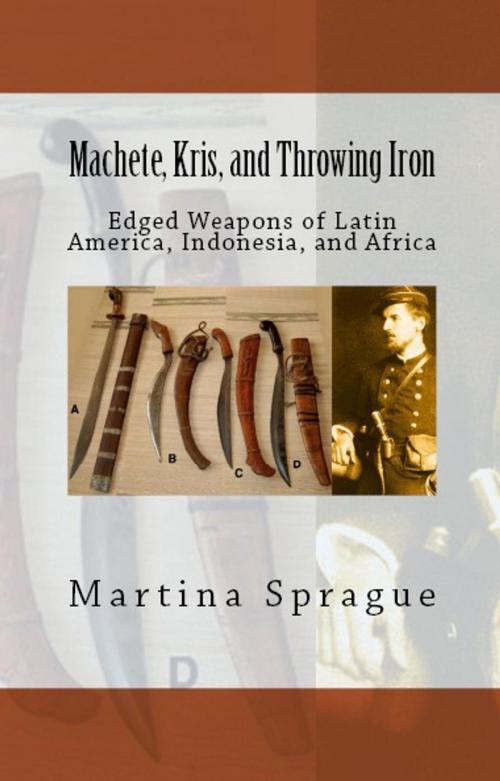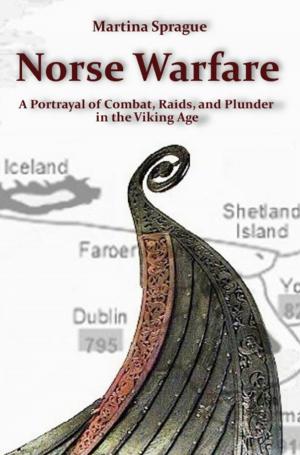Machete, Kris, and Throwing Iron: Edged Weapons of Latin America, Indonesia, and Africa
Knives, Swords, and Bayonets: A World History of Edged Weapon Warfare, #2
Nonfiction, History, Military, Weapons| Author: | Martina Sprague | ISBN: | 9781386097822 |
| Publisher: | Martina Sprague | Publication: | February 18, 2018 |
| Imprint: | Language: | English |
| Author: | Martina Sprague |
| ISBN: | 9781386097822 |
| Publisher: | Martina Sprague |
| Publication: | February 18, 2018 |
| Imprint: | |
| Language: | English |
Large knives with origins as farming and brush cutting tools are often associated with warfare in geographical regions of rough terrain, dense jungle, hills, and in societies without centralized leadership. They have found use as weapons in guerrilla warfare and internal rebellions. The machete has been employed extensively in political uprisings, particularly in Third World countries with unstable governments; for example, in Latin America, Southeast Asia, and Africa.
Some of the most varied types of edged weaponry, however, can be found in Indonesia. Since this region faced foreign occupiers, conflicts proved common, forcing the natives to resort to knives that could easily be carried on one’s person. Indonesian edged weapons saw use during the Philippine-American War of 1899-1902.
Africa is yet a region that has relied on edged weaponry. Because of a need for people to develop ethnic and cultural identity, regional weapons often feature significant differences in shape and size. The edged weapons of Africa frequently demonstrate the cultural connection between war and peace, life and death, offense and defense that existed in peoples’ lives.
This book focuses on three geographical regions associated with jungle, desert, and guerrilla warfare from around the fifteenth century to modern day: Latin America, Indonesia, and Africa. The book starts by discussing the machete and other big-bladed weapons used extensively in Central America, Cuba, Mexico, and Chile. Next it explores the unique knives of Indonesia, with particular focus on the kris. It then examines the bladed weapons of the different regions of the African continent, including the tactics used in pre- and post-colonial warfare. The history of metallurgic science and the migration of weapons to different regions are also explored. The concluding remarks summarize the main points of each section.
Large knives with origins as farming and brush cutting tools are often associated with warfare in geographical regions of rough terrain, dense jungle, hills, and in societies without centralized leadership. They have found use as weapons in guerrilla warfare and internal rebellions. The machete has been employed extensively in political uprisings, particularly in Third World countries with unstable governments; for example, in Latin America, Southeast Asia, and Africa.
Some of the most varied types of edged weaponry, however, can be found in Indonesia. Since this region faced foreign occupiers, conflicts proved common, forcing the natives to resort to knives that could easily be carried on one’s person. Indonesian edged weapons saw use during the Philippine-American War of 1899-1902.
Africa is yet a region that has relied on edged weaponry. Because of a need for people to develop ethnic and cultural identity, regional weapons often feature significant differences in shape and size. The edged weapons of Africa frequently demonstrate the cultural connection between war and peace, life and death, offense and defense that existed in peoples’ lives.
This book focuses on three geographical regions associated with jungle, desert, and guerrilla warfare from around the fifteenth century to modern day: Latin America, Indonesia, and Africa. The book starts by discussing the machete and other big-bladed weapons used extensively in Central America, Cuba, Mexico, and Chile. Next it explores the unique knives of Indonesia, with particular focus on the kris. It then examines the bladed weapons of the different regions of the African continent, including the tactics used in pre- and post-colonial warfare. The history of metallurgic science and the migration of weapons to different regions are also explored. The concluding remarks summarize the main points of each section.















